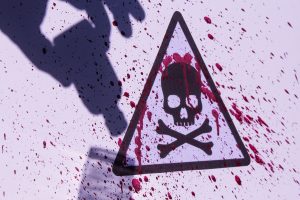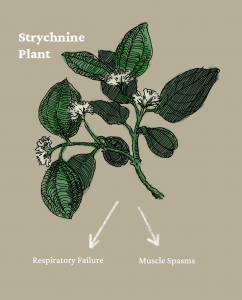Picture this: You’re attending a rather fancy royal wedding, the band is playing, and the food is divine. The king is taking a sip of his wine. Everything seems rather quaint. But, just as you’re reaching for another hors d’oeuvre, the king starts gasping for air, clamps his throat, and falls to the ground. His eyes grow bloodshot, his veins grow prominent through his pale skin and his nose begins to bleed profusely.
If you’re a Game of Thrones fanatic, this scene might sound familiar to you. (Spoiler alert!) In Season 4 Episode 2, King Joffrey dies epically from poisoned wine. Only a tiny drop of this particularly gruesome little weapon shuts off the victim’s windpipe completely, causing death by asphyxiation.
Well, if you’re King Joffrey, then you deserved it. But, if you’re any other human being, poison is something you generally want to avoid–but it might be harder than you think.
Poison is any drug, chemical, gas or venom that can be swallowed, inhaled, touched or injected, and disrupts normal body functions as a result. Some household items, such as bleach or nail polish, are only considered poisonous if consumed orally. In many cases, poisoning occurs when people neglect the phrase, “everything in moderation.” Certain gases, such as carbon monoxide, become dangerous in high concentrations. Some of us may be slightly more familiar with alcohol poisoning. Heck, even slightly uncooked meat can cause food poisoning via salmonella bacteria, which affects 1 in 6 Americans every year. Apparently, we like our steaks as rare as they can get.

Our encounters with potential poisons mostly seem to result in a painful night of regrets either on or bent over the toilet. If, however, you were to accidentally down a glass of poisoned wine like King Joffrey, the effects would be far more severe. The exact effects of a certain poison on someone also depends on a variety of innate factors, such as one’s age, gender, metabolism, health, and more.
Most poisons operate in a common methodology: a biochemical enzyme is inactivated, which then creates a cellular effect. The final result is a physical and observable increase or decrease in the speed of certain body processes. When we endure prolonged stress of poisoning and struggle to restore homeostasis, also known as our bodies’ attempts at stabilizing our internal state, we experience symptoms like nausea, vomiting, dizziness, and coughing.
In King Joffrey’s case, he likely experienced a poison similar to strychnine, a white, odorless powder that can easily be mixed into a drink. Historically, strychnine has been used to treat human ailments; and more recently, it was used as rat pesticide. As a rather strong poison, only a tiny dosage can produce damaging and even fatal results. The potency of a poison’s toxicity, or the substance’s relative level of harmful effects, depends on its dosage. TDLO, or Toxic Dosage Low, is the lowest dosage that an individual can absorb and experience toxic effects. On the other side of the spectrum, LD50, or Lethal Dose 50, is the calculated amount of poison that causes death in 50% of the exposed population.
Since King Joffrey consumed an entire glass of poisoned wine, he most likely experienced an extremely high dosage. Consumption of strychnine results in a malfunction involving glycine, a chemical messenger that plays a role in allowing our nerves to switch muscles “on” and “off”. Glycine functions by attaching onto glycine receptors in the spinal cord. Strychnine will disrupt the normal role of glycine by acting as a ‘competitive inhibitor,’ forming itself into the shape of glycine and attaching itself onto the glycine receptor. By competing for the same spot, strychnine inhibits glycine from properly functioning.

By removing our muscles’ abilities to turn off, the person experiences severe muscle spasms; eventually the respiratory muscles begin to fail and the person stops breathing. In the best-case scenario, King Joffrey could have received treatment and walked away with brain damage or kidney failure. However, as he experienced the worst-case scenario with no medical intervention or treatment, death ensued.
That’s not to say King Joffrey didn’t go down without a fight–the poison must then battle the immune system. On an intracellular level, the body undergoes detoxification and attempts to turn the poison into a less harmful version of itself. Enzymes will convert lipid-soluble toxic compounds into polar compounds. These toxins can no longer be stored into our fatty tissues, but instead are transformed into a water-based version that can easily be secreted out of the body. The kidneys and liver also work hard to remove toxins that come from ingested foods or drink. Our body also attempts to fight off harmful toxins with white blood cells, which recognize and kill foreign pathogens.
Conversely, the foreign synthetics of poison and its man-made chemical structure makes it hard for your body to identify what it’s dealing with. Harmful pathogens will modify their own cell surface or release proteins that disguise themselves as the body’s own recognizable cells. This capability will stop our immune system from raising any red flags, allowing the intrusive pathogen to freely evade our body. When detoxification fails and our defenses are overwhelmed by a large dose of ingested toxic chemicals, the body will store these lipid-soluble toxins in our connective tissues. This further damages and impedes connective tissues’ ability to help transport toxic waste of our system.
Ultimately, King Joffrey was no match for the Strangler, as it quickly managed to work its way down to the targeted area of the body. In King Joffrey’s case, the ingested poison traveled through the gastrointestinal tract and the small intestine. A piece of advice: If you’re looking to kill someone as quickly as possible, there’s a specific ranking of speed in the pathways that a poison can take, with intravenous (vein) injection being the fastest and dermal (through the skin) being the slowest. Certain routes are considered faster and more hazardous than others due to their abilities to absorb the toxic substance into circulation. While dermal exposure will only absorb a small percentage of the exposed dose of toxins, intravenous injection into the bloodstream quickly and completely absorbs the exposed dose of toxins, making it a much more lethal pathway.
If there are, in fact, a thousand ways to die, poison probably ranks somewhere in the top fifty. As Maester Cressen, advisor to the king of science and medicine, said it best, “Such a small thing to hold the power of life and death.”
Sources:
- https://emergency.cdc.gov/agent/strychnine/basics/facts.asp
- https://www.ncbi.nlm.nih.gov/books/NBK459306/
- https://www.sciencelearn.org.nz/resources/364-poisons-and-toxins
- http://pmep.cce.cornell.edu/profiles/extoxnet/TIB/manifestations.html#:~:text=Poisons%20work%20by%20changing%20the,insecticide)%20may%20experience%20increased%20sweating.
- https://www.chem.fsu.edu/chemlab/chm1020c/Lecture%2010/01.php
- https://toxtutor.nlm.nih.gov/03-002.html
- http://pmep.cce.cornell.edu/profiles/extoxnet/TIB/dose-response.html
Illustrations by Diana Presas
Photography by Anne Marie Berry